Search
- Page Path
- HOME > Search
- [Korean]
- Flexible Hybrid Energy Harvester based on Thermoelectric Composite Film and Electrospun Piezopolymer Membranes
- Hyomin Jeon, Cheol Min Kim, Hyeon Jun Park, Bitna Bae, Hyejeong Choi, HakSu Jang, Kwi-Il Park
- J Powder Mater. 2025;32(2):104-112. Published online March 4, 2025
- DOI: https://doi.org/10.4150/jpm.2024.00458
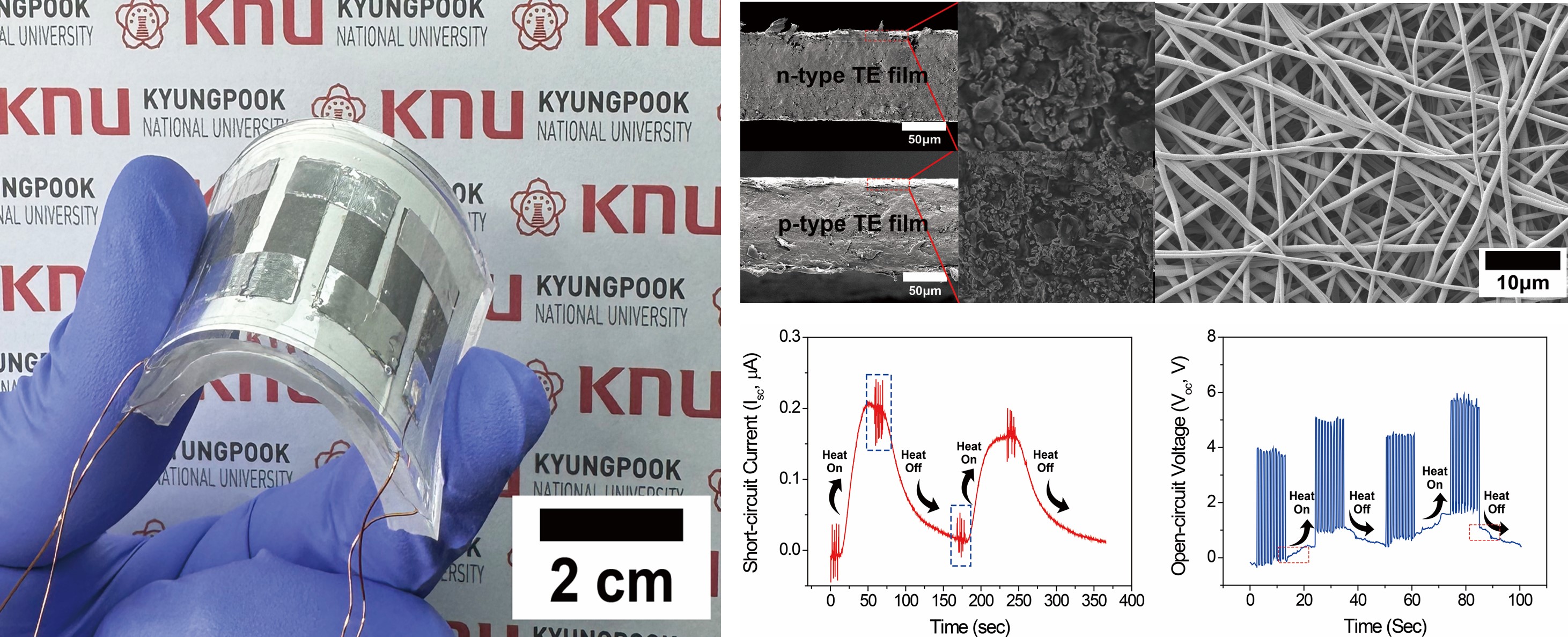
- 789 View
- 28 Download
-
 Abstract
Abstract
 PDF
PDF - A hybrid energy harvester that consisted of thermoelectric (TE) composite film and electrospun piezoelectric (PE) polymeric membranes was constructed. TE composites were fabricated by dispersing inorganic TE powders inside polyvinylidene fluoride elastomer using a drop-casting technique. The polyvinylidene fluoride-trifluoroethylene, which was chosen due to its excellent chemical resistance, mechanical stability, and biocompatibility, was electrospun onto an aluminum foil to fabricate the ultra-flexible PE membranes. To create a hybrid energy harvester that can simultaneously convert heat and mechanical energy resources into electricity, the TE composite films attached to the PE membrane were encapsulated with protective polydimethylsiloxane. The fabricated energy harvester converted the outputs with a maximum voltage of 4 V (PE performance) and current signals of 0.2 μA (TE performance) under periodical heat input and mechanical bending in hybrid modes. This study demonstrates the potential of the hybrid energy harvester for powering flexible and wearable electronics, offering a sustainable and reliable power source.
- [English]
- Recent Advances in Thermoelectric Materials and Devices: Improving Power Generation Performance
- Momanyi Amos Okirigiti, Cheol Min Kim, Hyejeong Choi, Nagamalleswara Rao Alluri, Kwi-Il Park
- J Powder Mater. 2025;32(1):1-15. Published online February 28, 2025
- DOI: https://doi.org/10.4150/jpm.2024.00395
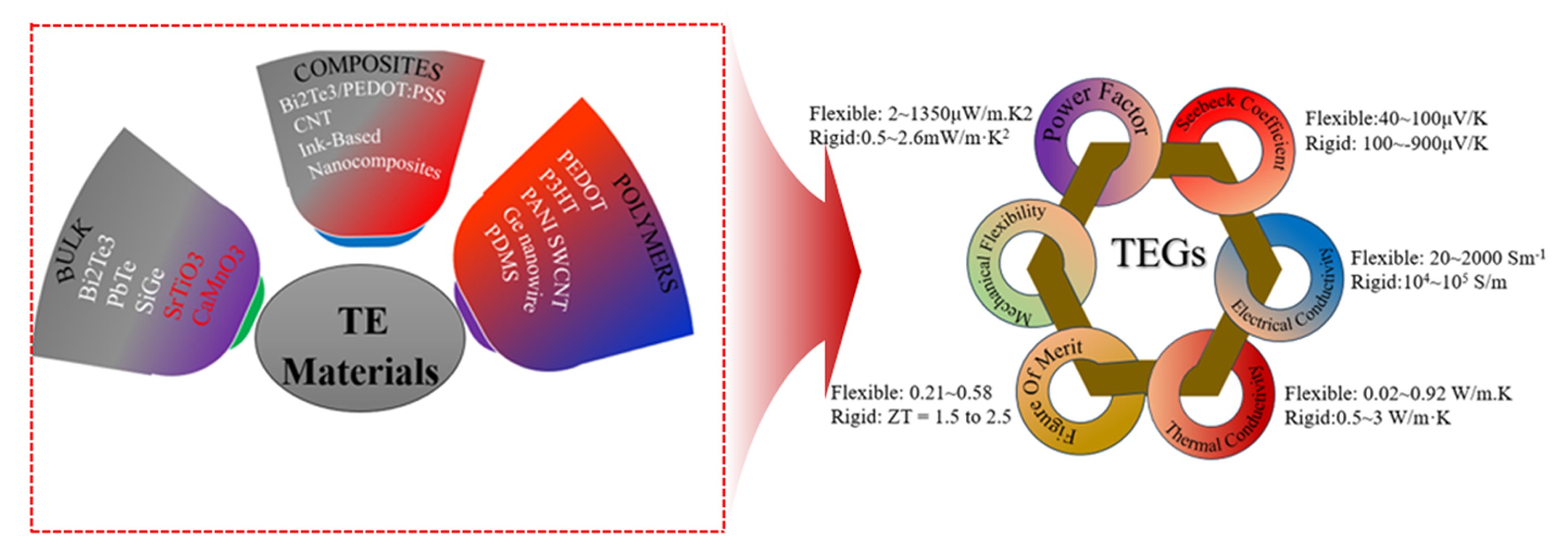
- 7,501 View
- 176 Download
- 1 Citations
-
 Abstract
Abstract
 PDF
PDF - Thermoelectric materials have been the focus of extensive research interest in recent years due to their potential in clean power generation from waste heat. Their conversion efficiency is primarily reflected by the dimensionless figure of merit, with higher values indicating better performance. There is a pressing need to discover materials that increase output power and improve performance, from the material level to device fabrication. This review provides a comprehensive analysis of recent advancements, such as Bi2Te3-based nanostructures that reduce thermal conductivity while maintaining electrical conductivity, GeTe-based high entropy alloys that utilize multiple elements for improved thermoelectric properties, porous metal-organic frameworks offering tunable structures, and organic/hybrid films that present low-cost, flexible solutions. Innovations in thermoelectric generator designs, such as asymmetrical geometries, segmented modules, and flexible devices, have further contributed to increased efficiency and output power. Together, these developments are paving the way for more effective thermoelectric technologies in sustainable energy generation.
-
Citations
Citations to this article as recorded by- Mathematical and simulation modeling of photovoltaic systems utilizing thermoelectric modules for effective thermal management
Muhammad Sohaib Tahir, Xue Dong, Muhammad Mansoor Khan
Results in Engineering.2025; 27: 106344. CrossRef
- Mathematical and simulation modeling of photovoltaic systems utilizing thermoelectric modules for effective thermal management
- [English]
- Investigation of the Thermal-to-Electrical Properties of Transition Metal-Sb Alloys Synthesized for Thermoelectric Applications
- Jong Min Park, Seungki Jo, Sooho Jung, Jinhee Bae, Linh Ba Vu, Kwi-Il Park, Kyung Tae Kim
- J Powder Mater. 2024;31(3):236-242. Published online June 27, 2024
- DOI: https://doi.org/10.4150/jpm.2024.00031
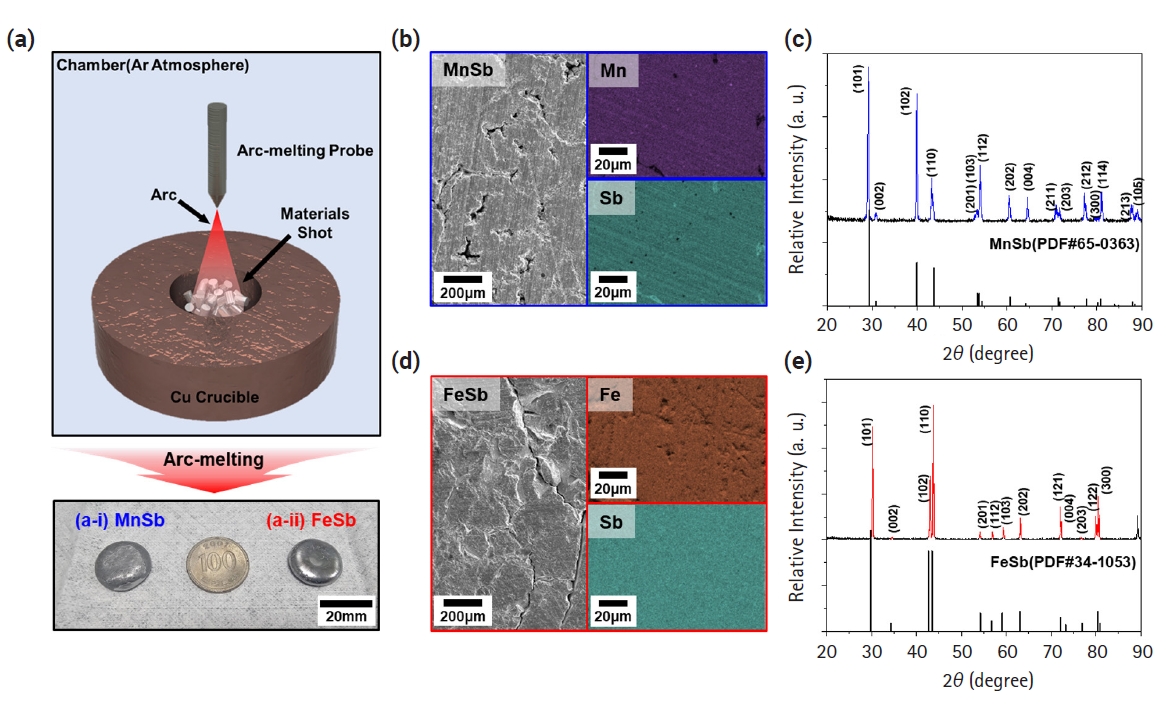
- 1,376 View
- 43 Download
- 2 Citations
-
 Abstract
Abstract
 PDF
PDF - The development of thermoelectric (TE) materials to replace Bi2Te3 alloys is emerging as a hot issue with the potential for wider practical applications. In particular, layered Zintl-phase materials, which can appropriately control carrier and phonon transport behaviors, are being considered as promising candidates. However, limited data have been reported on the thermoelectric properties of metal-Sb materials that can be transformed into layered materials through the insertion of cations. In this study, we synthesized FeSb and MnSb, which are used as base materials for advanced thermoelectric materials. They were confirmed as single-phase materials by analyzing X-ray diffraction patterns. Based on electrical conductivity, the Seebeck coefficient, and thermal conductivity of both materials characterized as a function of temperature, the zT values of MnSb and FeSb were calculated to be 0.00119 and 0.00026, respectively. These properties provide a fundamental data for developing layered Zintl-phase materials with alkali/alkaline earth metal insertions.
-
Citations
Citations to this article as recorded by- Improving thermoelectric properties of CuMnSb alloys via strategic alloying with magnetic MnSb and Cu
Jong Min Park, Seungki Jo, Soo-ho Jung, Jinhee Bae, Linh Ba Vu, Jihun Yu, Kyung Tae Kim
Materials Letters.2025; 381: 137796. CrossRef - Highly deformable and hierarchical 3D composite sponge for versatile thermoelectric energy conversion
Jong Min Park, Changyeon Baek, Min-Ku Lee, Nagamalleswara Rao Alluri, Gyoung-Ja Lee, Kyung Tae Kim, Kwi-Il Park
Applied Surface Science.2025; 692: 162730. CrossRef
- Improving thermoelectric properties of CuMnSb alloys via strategic alloying with magnetic MnSb and Cu
- [English]
- Exploring Thermoelectric Transport Properties and Band Parameters of n-Type Bi2-xSbxTe3 Compounds Using the Single Parabolic Band Model
- Linh Ba Vu, Soo-ho Jung, Jinhee Bae, Jong Min Park, Kyung Tae Kim, Injoon Son, Seungki Jo
- J Powder Mater. 2024;31(2):119-125. Published online April 30, 2024
- DOI: https://doi.org/10.4150/jpm.2024.00045

- 2,515 View
- 77 Download
- 5 Citations
-
 Abstract
Abstract
 PDF
PDF - The n-type Bi2-xSbxTe3 compounds have been of great interest due to its potential to achieve a high thermoelectric performance, comparable to that of p-type Bi2-xSbxTe3. However, a comprehensive understanding on the thermoelectric properties remains lacking. Here, we investigate the thermoelectric transport properties and band characteristics of n-type Bi2-xSbxTe3 (x = 0.1 – 1.1) based on experimental and theoretical considerations. We find that the higher power factor at lower Sb content results from the optimized balance between the density of state effective mass and nondegenerate mobility. Additionally, a higher carrier concentration at lower x suppresses bipolar conduction, thereby reducing thermal conductivity at elevated temperatures. Consequently, the highest zT of ~ 0.5 is observed at 450 K for x = 0.1 and, according to the single parabolic band model, it could be further improved by ~70 % through carrier concentration tuning.
-
Citations
Citations to this article as recorded by- Review of “Integrated Computer-Aided Process Engineering Session in the 17th International Symposium on Novel and Nano Materials (ISNNM, 14–18 November 2022)”
Yeon-Joo Lee, Pil-Ryung Cha, Hyoung-Seop Kim, Hyun-Joo Choi
MATERIALS TRANSACTIONS.2025; 66(1): 144. CrossRef - Enhanced energy harvesting performance of bendable thermoelectric generator enabled by trapezoidal-shaped legs
Momanyi Amos Okirigiti, Cheol Min Kim, Hyejeong Choi, Nagamalleswara Rao Alluri, Changyeon Baek, Min-Ku Lee, Gyoung-Ja Lee, Kwi-Il Park
Journal of Power Sources.2025; 631: 236254. CrossRef - Flexible hybrid thermoelectric films made of bismuth telluride-PEDOT:PSS composites enabled by freezing-thawing process and simple chemical treatment
Cheol Min Kim, Seoha Kim, Nagamalleswara Rao Alluri, Bitna Bae, Momanyi Amos Okirigiti, Gwang Hyun Kim, Hyeon Jun Park, Haksu Jang, Changyeon Baek, Min-Ku Lee, Gyoung-Ja Lee, Kwi-Il Park
Materials Today Chemistry.2025; 44: 102532. CrossRef - Enhanced Electrical Properties of 3D Printed Bi2Te3-Based Thermoelectric Materials via Hot Isostatic Pressing
Seungki Jo
Ceramist.2025; 28(1): 126. CrossRef - Hot isostatic pressing-driven fine-tuning of electrical properties in p- and n-type (Bi,Sb)2Te3 thermoelectric materials
Seungki Jo, Jeong Min Park, Linh Ba Vu, Haeum Park, Soo Ho Jung, Jinhee Bae, Jong Min Park, Jungho Choe, Kyung Tae Kim
Ceramics International.2025; 51(26): 51107. CrossRef
- Review of “Integrated Computer-Aided Process Engineering Session in the 17th International Symposium on Novel and Nano Materials (ISNNM, 14–18 November 2022)”
- [Korean]
- Fabrication of Bi2Te2.5Se0.5 by Combining Oxide-reduction and Compressive-forming Process and Its Thermoelectric Properties
- Young Soo Lim, Gil-Geun Lee
- J Powder Mater. 2024;31(1):50-56. Published online February 28, 2024
- DOI: https://doi.org/10.4150/KPMI.2024.31.1.50
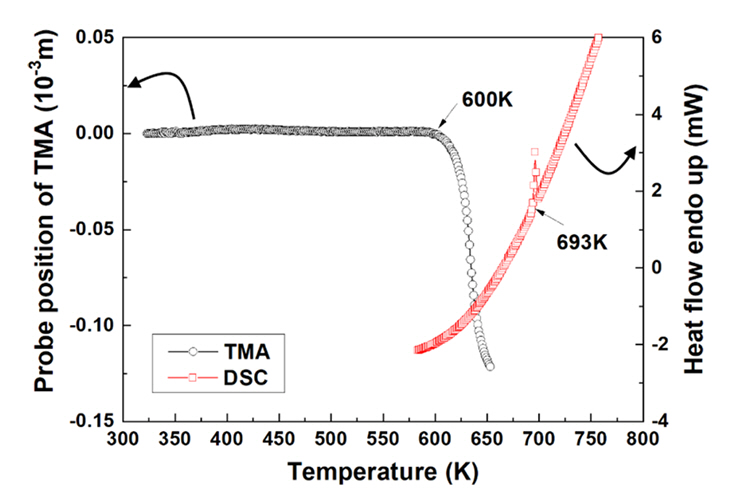
- 943 View
- 19 Download
- [English]
- Enhancing Electrical Properties of N-type Bismuth Telluride Alloys through Graphene Oxide Incorporation in Extrusion 3D Printing
- Jinhee Bae, Seungki Jo, Kyung Tae Kim
- J Powder Mater. 2023;30(4):318-323. Published online August 1, 2023
- DOI: https://doi.org/10.4150/KPMI.2023.30.4.318
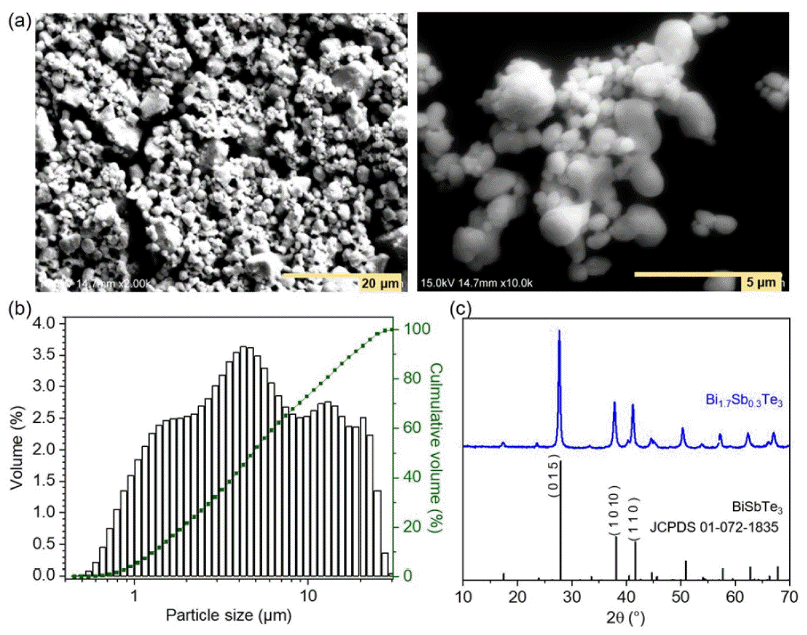
- 1,357 View
- 9 Download
- 1 Citations
-
 Abstract
Abstract
 PDF
PDF The thermoelectric effect, which converts waste heat into electricity, holds promise as a renewable energy technology. Recently, bismuth telluride (Bi2Te3)-based alloys are being recognized as important materials for practical applications in the temperature range from room temperature to 500 K. However, conventional sintering processes impose limitations on shape-changeable and tailorable Bi2Te3 materials. To overcome these issues, three-dimensional (3D) printing (additive manufacturing) is being adopted. Although some research results have been reported, relatively few studies on 3D printed thermoelectric materials are being carried out. In this study, we utilize extrusion 3D printing to manufacture n-type Bi1.7Sb0.3Te3 (N-BST). The ink is produced without using organic binders, which could negatively influence its thermoelectric properties. Furthermore, we introduce graphene oxide (GO) at the crystal interface to enhance the electrical properties. The formed N-BST composites exhibit significantly improved electrical conductivity and a higher Seebeck coefficient as the GO content increases. Therefore, we propose that the combination of the extrusion 3D printing process (Direct Ink Writing, DIW) and the incorporation of GO into N-BST offers a convenient and effective approach for achieving higher thermoelectric efficiency.
-
Citations
Citations to this article as recorded by- Exploring Thermoelectric Transport Properties and Band Parameters of n-Type Bi2-xSbxTe3 Compounds Using the Single Parabolic Band Model
Linh Ba Vu, Soo-ho Jung, Jinhee Bae, Jong Min Park, Kyung Tae Kim, Injoon Son, Seungki Jo
journal of Korean Powder Metallurgy Institute.2024; 31(2): 119. CrossRef
- Exploring Thermoelectric Transport Properties and Band Parameters of n-Type Bi2-xSbxTe3 Compounds Using the Single Parabolic Band Model
- [Korean]
- Thermoelectric Performance Enhancement of Sintered Bi-Te Pellets by Rotary-type Atomic Layer Deposition
- Myeong Jun Jung, Ji Young Park, Su Min Eun, Byung Joon Choi
- J Powder Mater. 2023;30(2):130-139. Published online April 1, 2023
- DOI: https://doi.org/10.4150/KPMI.2023.30.2.130
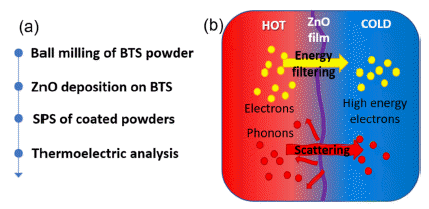
- 1,253 View
- 11 Download
- 4 Citations
-
 Abstract
Abstract
 PDF
PDF Thermoelectric materials and devices are energy-harvesting devices that can effectively recycle waste heat into electricity. Thermoelectric power generation is widely used in factories, engines, and even in human bodies as they continuously generate heat. However, thermoelectric elements exhibit poor performance and low energy efficiency; research is being conducted to find new materials or improve the thermoelectric performance of existing materials, that is, by ensuring a high figure-of-merit (zT) value. For increasing zT, higher σ (electrical conductivity) and S (Seebeck coefficient) and a lower к (thermal conductivity) are required. Here, interface engineering by atomic layer deposition (ALD) is used to increase zT of n-type BiTeSe (BTS) thermoelectric powders. ALD of the BTS powders is performed in a rotary-type ALD reactor, and 40 to 100 ALD cycles of ZnO thin films are conducted at 100°C. The physical and chemical properties and thermoelectric performance of the ALD-coated BTS powders and pellets are characterized. It is revealed that electrical conductivity and thermal conductivity are decoupled, and thus, zT of ALD-coated BTS pellets is increased by more than 60% compared to that of the uncoated BTS pellets. This result can be utilized in a novel method for improving the thermoelectric efficiency in materials processing.
-
Citations
Citations to this article as recorded by- Highly deformable and hierarchical 3D composite sponge for versatile thermoelectric energy conversion
Jong Min Park, Changyeon Baek, Min-Ku Lee, Nagamalleswara Rao Alluri, Gyoung-Ja Lee, Kyung Tae Kim, Kwi-Il Park
Applied Surface Science.2025; 692: 162730. CrossRef - Thermal Confinement and Filtering Effect of SnSe by Insertion of Atomic-Layer-Deposited ZnO Interfacial Layer
Myeong Jun Jung, Su Min Eun, Hogyoung Kim, Seong Keun Kim, Jongmin Byun, Byung Joon Choi
Korean Journal of Chemical Engineering.2025;[Epub] CrossRef - Investigation of the Thermal-to-Electrical Properties of Transition Metal-Sb Alloys Synthesized for Thermoelectric Applications
Jong Min Park, Seungki Jo, Sooho Jung, Jinhee Bae, Linh Ba Vu, Kwi-Il Park, Kyung Tae Kim
journal of Korean Powder Metallurgy Institute.2024; 31(3): 236. CrossRef - Enhancing Electrical Properties of N-type Bismuth Telluride Alloys through Graphene Oxide Incorporation in Extrusion 3D Printing
Jinhee Bae, Seungki Jo, Kyung Tae Kim
journal of Korean Powder Metallurgy Institute.2023; 30(4): 318. CrossRef
- Highly deformable and hierarchical 3D composite sponge for versatile thermoelectric energy conversion
- [Korean]
- Enhancement of Thermoelectric Performance in Spark Plasma Sintered p-Type Bi0.5Sb1.5Te3.0 Compound via Hot Isostatic Pressing (HIP) Induced Reduction of Lattice Thermal Conductivity
- Soo-Ho Jung, Ye Jin Woo, Kyung Tae Kim, Seungki Jo
- J Powder Mater. 2023;30(2):123-129. Published online April 1, 2023
- DOI: https://doi.org/10.4150/KPMI.2023.30.2.123
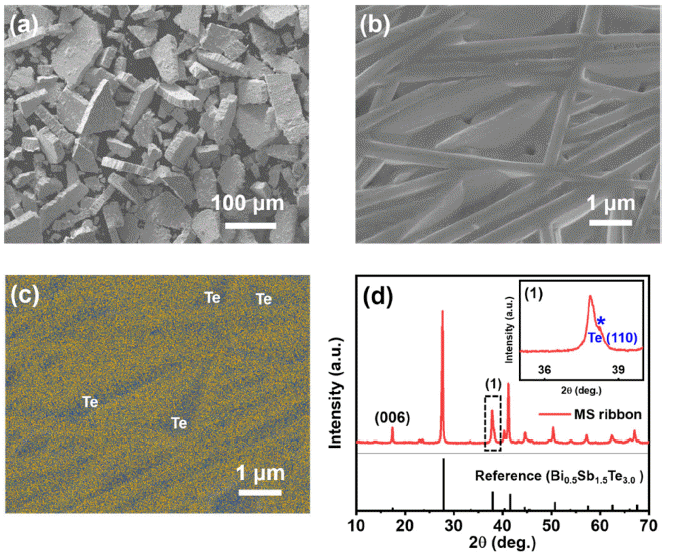
- 1,391 View
- 8 Download
- 4 Citations
-
 Abstract
Abstract
 PDF
PDF High-temperature and high-pressure post-processing applied to sintered thermoelectric materials can create nanoscale defects, thereby enhancing their thermoelectric performance. Here, we investigate the effect of hot isostatic pressing (HIP) as a post-processing treatment on the thermoelectric properties of
p -type Bi0.5Sb1.5Te3.0 compounds sintered via spark plasma sintering. The sample post-processed via HIP maintains its electronic transport properties despite the reduced microstructural texturing. Moreover, lattice thermal conductivity is significantly reduced owing to activated phonon scattering, which can be attributed to the nanoscale defects created during HIP, resulting in an ~18% increase in peakzT value, which reaches ~1.43 at 100°C. This study validates that HIP enhances the thermoelectric performance by controlling the thermal transport without having any detrimental effects on the electronic transport properties of thermoelectric materials.-
Citations
Citations to this article as recorded by- Enhanced Electrical Properties of 3D Printed Bi2Te3-Based Thermoelectric Materials via Hot Isostatic Pressing
Seungki Jo
Ceramist.2025; 28(1): 126. CrossRef - Exploring Thermoelectric Transport Properties and Band Parameters of n-Type Bi2-xSbxTe3 Compounds Using the Single Parabolic Band Model
Linh Ba Vu, Soo-ho Jung, Jinhee Bae, Jong Min Park, Kyung Tae Kim, Injoon Son, Seungki Jo
journal of Korean Powder Metallurgy Institute.2024; 31(2): 119. CrossRef - Investigation of the Thermal-to-Electrical Properties of Transition Metal-Sb Alloys Synthesized for Thermoelectric Applications
Jong Min Park, Seungki Jo, Sooho Jung, Jinhee Bae, Linh Ba Vu, Kwi-Il Park, Kyung Tae Kim
journal of Korean Powder Metallurgy Institute.2024; 31(3): 236. CrossRef - Enhancing Electrical Properties of N-type Bismuth Telluride Alloys through Graphene Oxide Incorporation in Extrusion 3D Printing
Jinhee Bae, Seungki Jo, Kyung Tae Kim
journal of Korean Powder Metallurgy Institute.2023; 30(4): 318. CrossRef
- Enhanced Electrical Properties of 3D Printed Bi2Te3-Based Thermoelectric Materials via Hot Isostatic Pressing
- [Korean]
- Recent Studies on Performance Enhancement of Polycrystal SnSe Thermoelectric Materials
- Myeong Jun Jung, Byung Joon Choi
- J Powder Mater. 2022;29(2):152-158. Published online April 1, 2022
- DOI: https://doi.org/10.4150/KPMI.2022.29.2.152
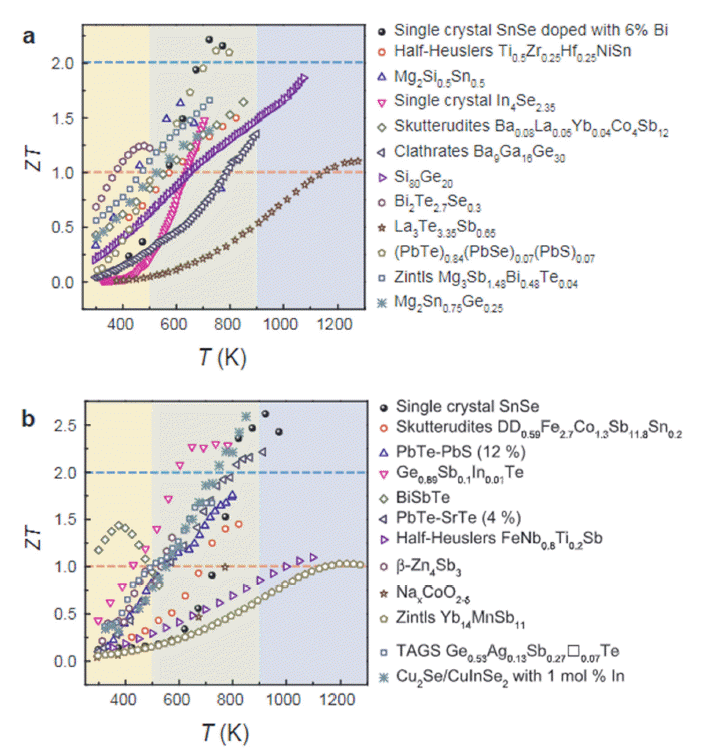
- 924 View
- 5 Download
- 1 Citations
-
 Abstract
Abstract
 PDF
PDF Thermoelectric materials can reversely convert heat and electricity into each other; therefore, they can be very useful for energy harvesting from heat waste. Among many thermoelectrical materials, SnSe exhibits outstanding thermoelectric performance along the particular direction of a single crystal. However, single-crystal SnSe has poor mechanical properties and thus it is difficult to apply for mass production. Therefore, polycrystalline SnSe materials may be used to replace single-crystal SnSe by overcoming its inferior thermoelectric performance owing to surface oxidation. Considerable efforts are currently focused on enhancing the thermoelectric performance of polycrystalline SnSe. In this study, we briefly review various enhancement methods for SnSe thermoelectric materials, including doping, texturing, and nano-structuring. Finally, we discuss the future prospects of SnSe thermoelectric powder materials.
-
Citations
Citations to this article as recorded by- The Mechanism Behind the High zT of SnSe2 Added SnSe at High Temperatures
JunSu Kim, Seong-Mee Hwang, Hyunjin Park, Yinglu Tang, Won-Seon Seo, Chae Woo Ryu, Heesun Yang, Weon Ho Shin, Hyun-Sik Kim
Korean Journal of Metals and Materials.2023; 61(11): 857. CrossRef
- The Mechanism Behind the High zT of SnSe2 Added SnSe at High Temperatures
- [Korean]
- Recent progress on Performance Improvements of Thermoelectric Materials using Atomic Layer Deposition
- Seunghyeok Lee, Tae Joo Park, Seong Keun Kim
- J Powder Mater. 2022;29(1):56-62. Published online February 1, 2022
- DOI: https://doi.org/10.4150/KPMI.2022.29.1.56
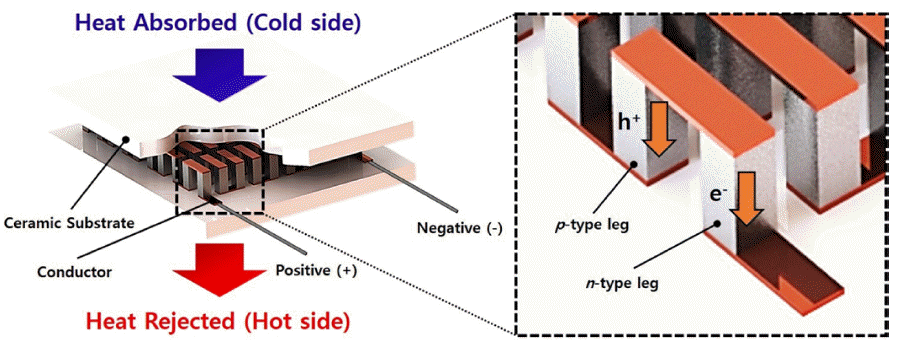
- 1,305 View
- 27 Download
-
 Abstract
Abstract
 PDF
PDF Atomic layer deposition (ALD) is a promising technology for the uniform deposition of thin films. ALD is based on a self-limiting mechanism, which can effectively deposit thin films on the surfaces of powders of various sizes. Numerous studies are underway to improve the performance of thermoelectric materials by forming core-shell structures in which various materials are deposited on the powder surface using ALD. Thermoelectric materials are especially relevant as clean energy storage materials due to their ability to interconvert between thermal and electrical energy by the Seebeck and Peltier effects. Herein, we introduce a surface and interface modification strategy based on ALD to control the performance of thermoelectric materials. We also discuss the properties of the interface between various deposition materials and thermoelectric materials.
- [Korean]
- Rotation Speed Dependence of ZnO Coating Layer on SnSe powders by Rotary Atomic Layer Deposition Reactor
- Myeong Jun Jung, Ye Jun Yun, Jongmin Byun, Byung Joon Choi
- J Korean Powder Metall Inst. 2021;28(3):239-245. Published online June 1, 2021
- DOI: https://doi.org/10.4150/KPMI.2021.28.3.239
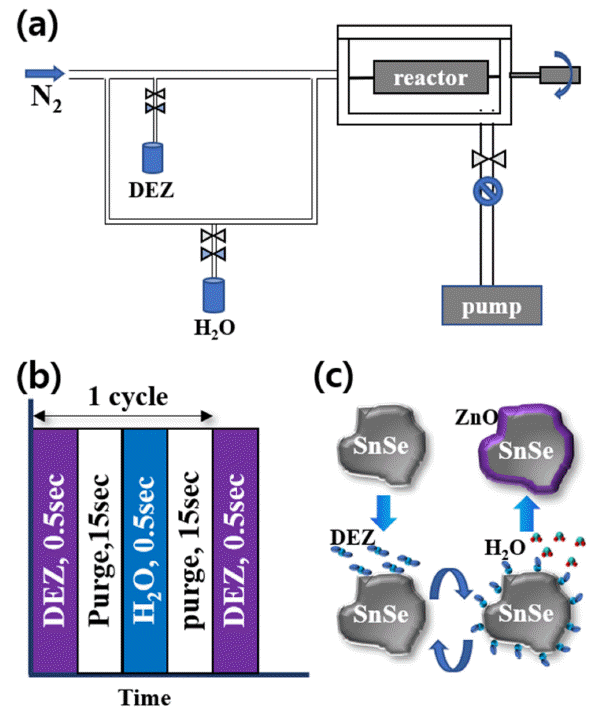
- 483 View
- 2 Download
- 1 Citations
-
 Abstract
Abstract
 PDF
PDF The SnSe single crystal shows an outstanding figure of merit (
ZT ) of 2.6 at 973 K; thus, it is considered to be a promising thermoelectric material. However, the mass production of SnSe single crystals is difficult, and their mechanical properties are poor. Alternatively, we can use polycrystalline SnSe powder, which has better mechanical properties. In this study, surface modification by atomic layer deposition (ALD) is chosen to increase theZT value of SnSe polycrystalline powder. SnSe powder is ground by a ball mill. An ALD coating process using a rotary-type reactor is adopted. ZnO thin films are grown by 100 ALD cycles using diethylzinc and H2O as precursors at 100°C. ALD is performed at rotation speeds of 30, 40, 50, and 60 rpm to examine the effects of rotation speed on the thin film characteristics. The physical and chemical properties of ALD-coated SnSe powders are characterized by scanning and tunneling electron microscopy combined with energy-dispersive spectroscopy. The results reveal that a smooth oxygenrich ZnO layer is grown on SnSe at a rotation speed of 30 rpm. This result can be applied for the uniform coating of a ZnO layer on various powder materials.-
Citations
Citations to this article as recorded by- Thermal Confinement and Filtering Effect of SnSe by Insertion of Atomic-Layer-Deposited ZnO Interfacial Layer
Myeong Jun Jung, Su Min Eun, Hogyoung Kim, Seong Keun Kim, Jongmin Byun, Byung Joon Choi
Korean Journal of Chemical Engineering.2025;[Epub] CrossRef
- Thermal Confinement and Filtering Effect of SnSe by Insertion of Atomic-Layer-Deposited ZnO Interfacial Layer
- [Korean]
- Thermoelectric Properties of PbTe Prepared by Spark Plasma Sintering of Nano Powders
- Eun-Young Jun, Ho-Young Kim, Cham Kim, Kyung-Sik Oh, Tai-Joo Chung
- J Korean Powder Metall Inst. 2018;25(5):384-389. Published online October 1, 2018
- DOI: https://doi.org/10.4150/KPMI.2018.25.5.384
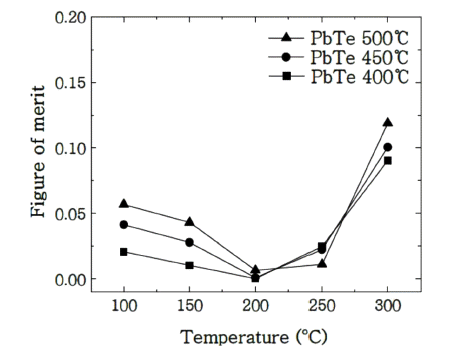
- 908 View
- 8 Download
- 2 Citations
-
 Abstract
Abstract
 PDF
PDF Nanoparticles of PbTe are prepared via chemical reaction of the equimolar aqueous solutions of Pb(CH3COO)2 and Te at 120°C. The size of the obtained particles is 100 nm after calcination in a hydrogen atmosphere. Dense specimens for the thermoelectric characterization are produced by spark plasma sintering of prepared powders at 400°C to 500°C under 80 MPa for 5 min. The relative densities of the prepared specimens reach approximately 97% and are identified as cubic based on X-ray diffraction analyses. The thermoelectric properties are evaluated between 100°C and 300°C via electrical conductivity, Seebeck coefficient, and thermal conductivity. Compared with PbTe ingot, the reduction of the thermal conductivities by more than 30% is verified via phonon scattering at the grain boundaries, which thus contributes to the increase in the figure of merit.
-
Citations
Citations to this article as recorded by- Improved Thermoelectric Performance of Cu3Sb1−x−ySnxInySe4 Permingeatites Double-Doped with Sn and In
Ho-Jeong Kim, Il-Ho Kim
Korean Journal of Metals and Materials.2023; 61(6): 422. CrossRef - Enhancing Electrical Properties of N-type Bismuth Telluride Alloys through Graphene Oxide Incorporation in Extrusion 3D Printing
Jinhee Bae, Seungki Jo, Kyung Tae Kim
journal of Korean Powder Metallurgy Institute.2023; 30(4): 318. CrossRef
- Improved Thermoelectric Performance of Cu3Sb1−x−ySnxInySe4 Permingeatites Double-Doped with Sn and In
- [English]
- Investigation of Spark Plasma Sintering Temperature on Microstructure and Thermoelectric Properties of p-type Bi-Sb-Te alloys
- Jin-Koo Han, Dong-won Shin, Babu Madavali, Soon-Jik Hong
- J Korean Powder Metall Inst. 2017;24(2):115-121. Published online April 1, 2017
- DOI: https://doi.org/10.4150/KPMI.2017.24.2.115
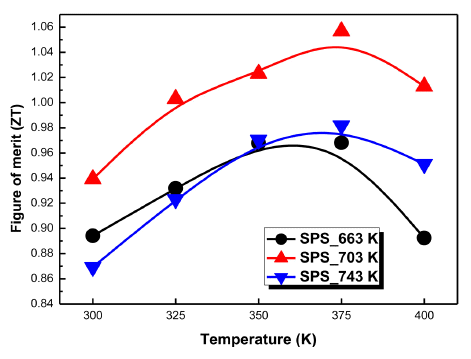
- 1,094 View
- 4 Download
- 1 Citations
-
 Abstract
Abstract
 PDF
PDF In this work, p-type Bi−Sb−Te alloys powders are prepared using gas atomization, a mass production powder preparation method involving rapid solidification. To study the effect of the sintering temperature on the microstructure and thermoelectric properties, gas-atomized powders are consolidated at different temperatures (623, 703, and 743 K) using spark plasma sintering. The crystal structures of the gas-atomized powders and sintered bulks are identified using an X-ray diffraction technique. Texture analysis by electron backscatter diffraction reveals that the grains are randomly oriented in the entire matrix, and no preferred orientation in any unique direction is observed. The hardness values decrease with increasing sintering temperature owing to a decrease in grain size. The conductivity increases gradually with increasing sintering temperature, whereas the Seebeck coefficient decreases owing to increases in the carrier mobility with grain size. The lowest thermal conductivity is obtained for the bulk sintered at a low temperature (603 K), mainly because of its fine-grained microstructure. A peak ZT of 1.06 is achieved for the sample sintered at 703 K owing to its moderate electrical conductivity and sustainable thermal conductivity.
-
Citations
Citations to this article as recorded by- Influence of the SPS heating rate on the optical and mechanical properties of Y2O3-MgO nanocomposites
Seok-Min Yong
Journal of Ceramic Processing Research.2019; 20(1): 59. CrossRef
- Influence of the SPS heating rate on the optical and mechanical properties of Y2O3-MgO nanocomposites
- [English]
- Optimization of Spark Plasma Sintering Temperature Conditions for Enhancement of Thermoelectric Performance in Gas-Atomized Bi0.5Sb1.5Te3 Compound
- Kwang-yong Jeong, Chul Hee Lee, Peyala Dharmaiah, Soon-Jik Hong
- J Korean Powder Metall Inst. 2017;24(2):108-114. Published online April 1, 2017
- DOI: https://doi.org/10.4150/KPMI.2017.24.2.108

- 976 View
- 8 Download
- 3 Citations
-
 Abstract
Abstract
 PDF
PDF We fabricate fine (<20 μm) powders of Bi0.5Sb1.5Te3 alloys using a large-scale production method and subsequently consolidate them at temperatures of 573, 623, and 673 K using a spark plasma sintering process. The microstructure, mechanical properties, and thermoelectric properties are investigated for each sintering temperature. The microstructural features of both the powders and bulks are characterized by scanning electron microscopy, and the crystal structures are analyzed by X-ray diffraction analysis. The grain size increases with increasing sintering temperature from 573 to 673 K. In addition, the mechanical properties increase significantly with decreasing sintering temperature owing to an increase in grain boundaries. The results indicate that the electrical conductivity and Seebeck coefficient (217 μV/K) of the sample sintered at 673 K increase simultaneously owing to decreased carrier concentration and increased mobility. As a result, a high
ZT value of 0.92 at 300 K is achieved. According to the results, a sintering temperature of 673 K is preferable for consolidation of fine (<20 μm) powders.-
Citations
Citations to this article as recorded by- Complex microstructure induced high thermoelectric performances of p-type Bi–Sb–Te alloys
Eun-Ha Go, Babu Madavali, Min-Woo Shin, Sung Ho Song, Soon-Jik Hong
Materials Chemistry and Physics.2023; 307: 128156. CrossRef - Role of sintering temperature on electronic and mechanical properties of thermoelectric material: A theoretical and experimental study of TiCoSb half-Heusler alloy
Ajay Kumar Verma, Kishor Kumar Johari, Kriti Tyagi, Durgesh Kumar Sharma, Pawan Kumar, Sudhir Kumar, Sivaiah Bathula, S.R. Dhakate, Bhasker Gahtori
Materials Chemistry and Physics.2022; 281: 125854. CrossRef - Enhanced thermoelectric properties of Li and Mg co−substituted Bi2Sr2Co2O fabricated by combined conventional sintering and spark plasma sintering
K. Park, H.Y. Hong, S.Y. Gwon
Inorganic Chemistry Communications.2022; 145: 110005. CrossRef
- Complex microstructure induced high thermoelectric performances of p-type Bi–Sb–Te alloys
- [Korean]
- Investigation on the Thermoelectric Properties of Bismuth Telluride Matrix Composites by Addition of Graphene Oxide Powders
- Kyung Tae Kim, Taesik Min, Dong Won Kim
- J Korean Powder Metall Inst. 2016;23(4):263-269. Published online August 1, 2016
- DOI: https://doi.org/10.4150/KPMI.2016.23.4.263
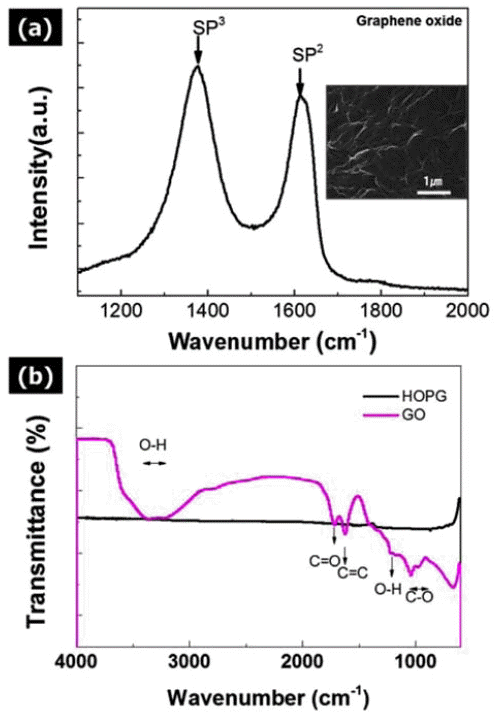
- 657 View
- 1 Download
- 6 Citations
-
 Abstract
Abstract
 PDF
PDF Graphene oxide (GO) powder processed by Hummer's method is mixed with p-type Bi2Te3 based thermoelectric materials by a high-energy ball milling process. The synthesized GO-dispersed p-type Bi2Te3 composite powder has a composition of Bi0.5Sb1.5Te3 (BSbT), and the powder is consolidated into composites with different contents of GO powder by using the spark plasma sintering (SPS) process. It is found that the addition of GO powder significantly decreases the thermal conductivity of the pure BSbT material through active phonon scattering at the newly formed interfaces. In addition, the electrical properties of the GO/BSbT composites are degraded by the addition of GO powder except in the case of the 0.1 wt% GO/BSbT composite. It is found that defects on the surface of GO powder hinder the electrical transport properties. As a result, the maximum thermoelectric performance (ZT value of 0.91) is achieved from the 0.1% GO/BSbT composite at 398 K. These results indicate that introducing GO powder into thermoelectric materials is a promising method to achieve enhanced thermoelectric performance due to the reduction in thermal conductivity.
-
Citations
Citations to this article as recorded by- Nanocomposite Strategy toward Enhanced Thermoelectric Performance in Bismuth Telluride
Hua‐Lu Zhuang, Jincheng Yu, Jing‐Feng Li
Small Science.2025;[Epub] CrossRef - Exploring Thermoelectric Transport Properties and Band Parameters of n-Type Bi2-xSbxTe3 Compounds Using the Single Parabolic Band Model
Linh Ba Vu, Soo-ho Jung, Jinhee Bae, Jong Min Park, Kyung Tae Kim, Injoon Son, Seungki Jo
journal of Korean Powder Metallurgy Institute.2024; 31(2): 119. CrossRef - Enhancing Electrical Properties of N-type Bismuth Telluride Alloys through Graphene Oxide Incorporation in Extrusion 3D Printing
Jinhee Bae, Seungki Jo, Kyung Tae Kim
journal of Korean Powder Metallurgy Institute.2023; 30(4): 318. CrossRef - Advancement of thermoelectric performances through the dispersion of expanded graphene on p-type BiSbTe alloys
Eun-Ha Go, Rathinam Vasudevan, Babu Madavali, Peyala Dharmaiah, Min-Woo Shin, Sung Ho Song, Soon-Jik Hong
Powder Metallurgy.2023; 66(5): 722. CrossRef - The role of edge-oxidized graphene to improve the thermopower of p-type bismuth telluride-based thick films
Young Min Cho, Kyung Tae Kim, Gi Seung Lee, Soo Hyung Kim
Applied Surface Science.2019; 476: 533. CrossRef - The Preparation and Growth Mechanism of the Recovered Bi2Te3 Particles with Respect to Surfactants
Hyeongsub So, Eunpil Song, Yong-Ho Choa, Kun-Jae Lee
Journal of Korean Powder Metallurgy Institute.2017; 24(2): 141. CrossRef
- Nanocomposite Strategy toward Enhanced Thermoelectric Performance in Bismuth Telluride
- [English]
- Effects of Hydrogen Reduction in Microstructure, Mechanical and Thermoelectric Properties of Gas Atomized
n -type Bi2Te2.7 Se0.3 Material - Pradip Rimal, Sang-Min Yoon, Eun-Bin Kim, Chul-Hee Lee, Soon-Jik Hong
- J Korean Powder Metall Inst. 2016;23(2):126-131. Published online April 1, 2016
- DOI: https://doi.org/10.4150/KPMI.2016.23.2.126

- 731 View
- 5 Download
- 6 Citations
-
 Abstract
Abstract
 PDF
PDF The recent rise in applications of thermoelectric materials has attracted interest in studies toward the fabrication of thermoelectric materials using mass production techniques. In this study, we successfully fabricate
n -type Bi2Te2.7Se0.3 material by a combination of mass production powder metallurgy techniques, gas atomization, and spark plasma sintering. In addition, to examine the effects of hydrogen reduction in the microstructure, the thermoelectric and mechanical properties are measured and analyzed. Here, almost 60% of the oxygen content of the powder are eliminated after hydrogen reduction for 4 h at 360°C. Micrographs of the powder show that the reduced powder had a comparatively clean surface and larger grain sizes than unreduced powder. The density of the consolidated bulk using as-atomized powder and reduced atomized powder exceeds 99%. The thermoelectric power factor of the sample prepared by reduction of powder is 20% better than that of the sample prepared using unreduced powder.-
Citations
Citations to this article as recorded by- Tuning of power factor in bismuth selenide through Sn/Te co doping for low temperature thermoelectric applications
Ganesh Shridhar Hegde, Ashwatha Narayana Prabhu, Ramakrishna Nayak, C. F. Yang, Y. K. Kuo
Applied Physics A.2024;[Epub] CrossRef - Enhancing thermoelectric performance of K-doped polycrystalline SnSe through band engineering tuning and hydrogen reduction
Nan Xin, Yifei Li, Guihua Tang, Longyun Shen
Journal of Alloys and Compounds.2022; 899: 163358. CrossRef - The effect of powder pre-treatment on the mechanical and thermoelectric properties of spark plasma sintered N-type bismuth telluride
Ahmed A. Abdelnabi, Vickram Lakhian, Joseph R. McDermid, James S. Cotton
Journal of Alloys and Compounds.2021; 874: 159782. CrossRef - Investigation of Spark Plasma Sintering Temperature on Microstructure and Thermoelectric Properties of p-type Bi-Sb-Te alloys
Jin-Koo Han, Dong-won Shin, Babu Madavali, Soon-Jik Hong
Journal of Korean Powder Metallurgy Institute.2017; 24(2): 115. CrossRef - The Preparation and Growth Mechanism of the Recovered Bi2Te3 Particles with Respect to Surfactants
Hyeongsub So, Eunpil Song, Yong-Ho Choa, Kun-Jae Lee
Journal of Korean Powder Metallurgy Institute.2017; 24(2): 141. CrossRef - Enhanced thermoelectric cooling properties of Bi2Te3−xSex alloys fabricated by combining casting, milling and spark plasma sintering
Seung Tek Han, Pradip Rimal, Chul Hee Lee, Hyo-Seob Kim, Yongho Sohn, Soon-Jik Hong
Intermetallics.2016; 78: 42. CrossRef
- Tuning of power factor in bismuth selenide through Sn/Te co doping for low temperature thermoelectric applications
- [English]
- Investigation of Ball Size Effect on Microstructure and Thermoelectric Properties of
p -type BiSbTe by Mechanical Alloying - May Likha Lwin, Sang-min Yoon, Babu Madavali, Chul-Hee Lee, Soon-Jik Hong
- J Korean Powder Metall Inst. 2016;23(2):120-125. Published online April 1, 2016
- DOI: https://doi.org/10.4150/KPMI.2016.23.2.120

- 1,102 View
- 3 Download
- 4 Citations
-
 Abstract
Abstract
 PDF
PDF P -type ternary Bi0.5Sb1.5Te3 alloys are fabricated via mechanical alloying (MA) and spark plasma sintering (SPS). Different ball sizes are used in the MA process, and their effect on the microstructure; hardness, and thermoelectric properties of thep -type BiSbTe alloys are investigated. The phases of milled powders and bulks are identified using an X-ray diffraction technique. The morphology of milled powders and fracture surface of compacted samples are examined using scanning electron microscopy. The morphology, phase, and grain structures of the samples are not altered by the use of different ball sizes in the MA process. Measurements of the thermoelectric (TE) transport properties including the electrical conductivity, Seebeck coefficient, and power factor are measured at temperatures of 300- 400 K for samples treated by SPS. The TE properties do not depend on the ball size used in the MA process.-
Citations
Citations to this article as recorded by- Investigation of Spark Plasma Sintering Temperature on Microstructure and Thermoelectric Properties of p-type Bi-Sb-Te alloys
Jin-Koo Han, Dong-won Shin, Babu Madavali, Soon-Jik Hong
Journal of Korean Powder Metallurgy Institute.2017; 24(2): 115. CrossRef - Flexible Thermoelectric Device Using Thick Films for Energy Harvesting from the Human Body
Han Ki Cho, Da Hye Kim, Hye Sun Sin, Churl-Hee Cho, Seungwoo Han
Journal of the Korean Ceramic Society.2017; 54(6): 518. CrossRef - Investigation of the Microstructure and Thermoelectric Properties of P-Type BiSbTe Alloys by Usage of Different Revolutions Per Minute (RPM) During Mechanical Milling
S.-M. Yoon, B. Madavali, Y.-N. Yoon, S.-J. Hong
Archives of Metallurgy and Materials.2017; 62(2): 1167. CrossRef - Mechanical and thermoelectric properties of Bi2−xSbxTe3 prepared by using encapsulated melting and hot pressing
Woo-Jin Jung, Il-Ho Kim
Journal of the Korean Physical Society.2016; 69(8): 1328. CrossRef
- Investigation of Spark Plasma Sintering Temperature on Microstructure and Thermoelectric Properties of p-type Bi-Sb-Te alloys
- [Korean]
- Thermoelectric Properties in the Cu Doping Effects of the n-type Bi-Te Powders
- Min Soo Park, Hye Young Koo, Gook Hyun Ha, Yong Ho Park
- J Korean Powder Metall Inst. 2015;22(4):254-259. Published online August 1, 2015
- DOI: https://doi.org/10.4150/KPMI.2015.22.4.254

- 677 View
- 4 Download
-
 Abstract
Abstract
 PDF
PDF Bi2Te3 related compounds show the best thermoelectric properties at room temperature. However, n-type Bi2Te2.7Se0.3 showed no improvement on ZT values. To improve the thermolectric propterties of n-type Bi2Te2.7Se0.3, this research has Cu-doped n-type powder. This study focused on effects of Cu-doping method on the thermoelectric properties of n-type materials, and evaluated the comparison between the Cu chemical and mechanical doping. The synthesized powder was manufactured by the spark plasma sintering(SPS). The thermoelectric properties of the sintered body were evaluated by measuring their Seebeck coefficient, electrical resistivity, thermal conductivity, and hall coefficient. An introduction of a small amount of Cu reduced the thermal conductivity and improved the electrical properties with Seebeck coefficient. The authors provided the optimal concentration of Cu0.1Bi1.99Se0.3Te2.7. A figure of merit (ZT) value of 1.22 was obtained for Cu0.1Bi1.9Se0.3Te2.7 at 373K by Cu chemical doping, which was obviously higher than those of Cu0.1Bi1.9Se0.3Te2.7 at 373K by Cu mechanical doping (ZT=0.56) and Cu-free Bi2Se0.3Te2.7 (ZT=0.51).
TOP
 KPMI
KPMI


 First
First Prev
Prev


